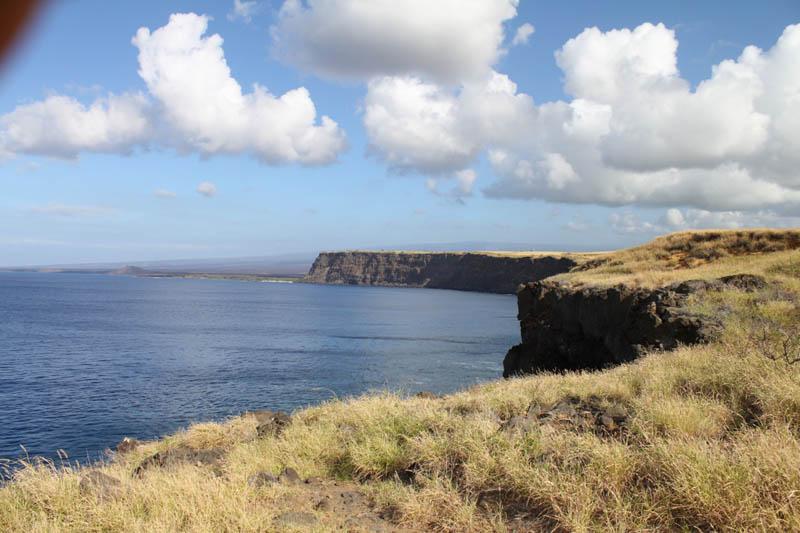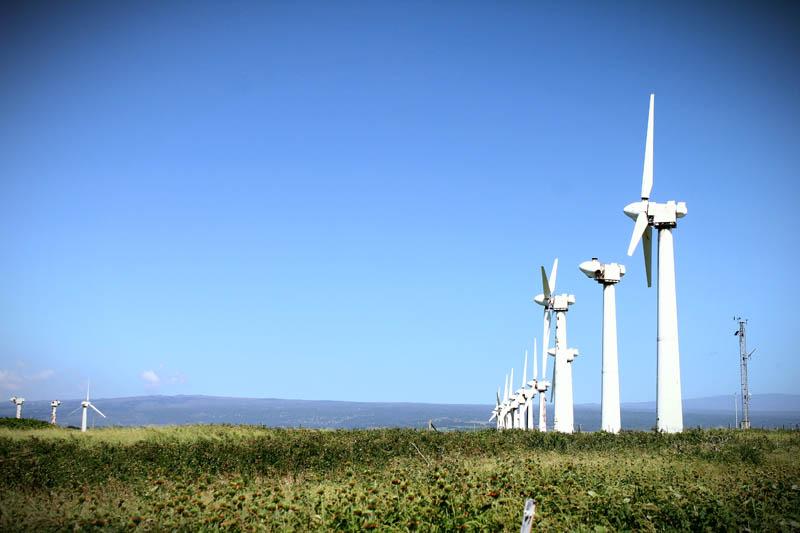
The southernmost point of the United States of America is Big Island’s South Point. It’s believed that it was here approximately 1200 years ago that Polynesian voyagers first landed in Hawaii upon discovering the untouched islands.
You may be surprised at how many guidebooks skip over this place, but south point has a lot to offer. From the towering cliffs and crystal waters teeming with fish to the green sand beach, it’s hard to get bored here.
Far removed from large towns, south point is a windswept countryside reminiscent of America’s midwest, but perched above the ocean. As you turn off the highway and begin the 12 mile journey down South Point Road you’ll pass lush pastures with bright electric green grass and
large plantations. Up here the land is fertile and wet, but as you travel towards the coastline it gets dryer and more windy. You pass two windfarms in your way. The first is old and not running with many of the turbines covered in rust. The second is sleek and new, providing
power for the southern part of the island.
When you finally reach the entrance to south point you’ll see a fork in the dirt/gravel road. Bear right to explore the cliffs and see the actual southernmost point, bear left to reach a small boat ramp and the green sand beach.
This land is dry and windy. The ground is an orange dust that will quickly cover your footwear. Even with the wind it can get quite hot here during midday. Make sure to bring plenty of water and sunscreen. There are no buildings or amenities here, so you must bring everything with you.

The waters around south point are more abundant than anywhere else around the island where fishing is allowed. Many spearfishing tournaments are held here, and you’ll likely see local fishermen with their lines in the water attached to rods at the tops of the cliffs.
Here, 40 feet above the water, is where many people test their wills by jumping into the sea. An activity referred to as “jumping south point”, it is not for the faint of heart.
The diving around this area is on par with the Kona coastline. However, there can be strong currents here. Only experienced divers who have researched the current conditions in advance should enter this water. The coastline is frequented by whales, dolphins, and many sharks. This spot has more Great White sightings than anywhere else on the island. Large marine animals can often be seen offshore from the cliffs above, so you may not have to get into the water to witness something big.
There are canoe launches perched atop the cliffs here as well, and a large coastal cave accessible from the top of the cliff that resembles a place pirates might hide their stolen booty.
The eastern part of south point drops in elevation and heavy waves buffet the coastline on the way to the green sand beach. Ocean currents deposit all sorts of things on this beach (much of it trash). Non-native field mice are abundant here and can be seen hopping about along the rocks. The road to the green sand beach is extremely bumpy. Many may elect to park at the small boat harbor near the cliffs (you’ll see it if you take the left fork at the entrance) and walk to the green sand beach. The road is 3 miles and can only be driven in an off-road 4wd vehicle.
The green sand beach is the only one of its kind in Hawaii, made from the erosion of a lava flow rich in Olivine. Relaxing on a green beach with the waves crashing around you is an unforgettable experience.
South point is also a great place to watch sunrises and sunsets, as both can be clearly seen over the ocean.
Allow at least an hour to explore the area, and half a day if planning on hiking to the green sand beach.
Why go to south point?
Stunning views, world class spearfishing, a green sand beach, and other amazing scenery.
